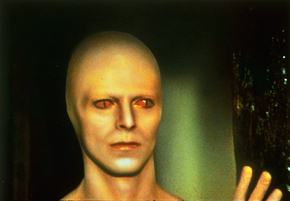

UK science fiction
1976
color 138 min.
Director: Nicolas Roeg
CLV: $99.95 - available
2 discs, catalog # CC1312L

Released the year
before Close Encounters of the Third Kind and Star Wars, Nicolas
Roeg's The Man Who Fell to Earth is a science-fiction film without
science, a terrestrial space opera minus matte shots, models, or pyrotechnics
that leaves us not wondering at the stars but grieving for ourselves.
Maddeningly structured, defiantly ambiguous (some say incoherent), yet
powerfully moving, it was described by its director at the time of its release
simply as "a mysterious American love story."The Man Who Fell to
Earth is a serious film that runs to garishness, a cerebral film flooded
with emotion, in which plot counts less than picture and event less than
essence, silence carries as much weight as speech, and much remains
intentionally unexplained. "If questions are answered patly," Roeg has said,
"the audience is distanced." That attitude has created a career's worth of
troublesome, even anti-logical movies -- from Performance,
Walkabout, and Don't Look Now in the '70s to
Insignificance and Track 29 in the '80s -- that trust the viewer
to gather, sort, and tie together (or not) the loose ends. Although
unsympathetic critics deem it a failing, it's the very quality that makes Roeg
a revival house perennial.
In The Man Who Fell to Earth, adapted from
a 1963 novel by Walter Tevis (who also wrote The Hustler), the director
is at his most flamboyantly fractured. Screenwriter Paul Mayersberg has
described its parade of scenes as "circus acts following one another -- the
funny, the violent, the frightening, the sad, the horrific, the spectacular. "
Roeg delights here in "taking away the crutch of time" ("It has puzzled people
whehter 25 minutes or 25 years have passed in the film"), eliminating
transitions, cross-cutting, flashing forward and back, piling dissolve upon
dissolve, letting the camera jerk and twirl and zoo, -- finding new ways to see
familiar things, while speculating on what the world might look like to someone
from Out There. Pauline Kael called Roeg "perhaps the most visually seductive
of directors, and this is a film of symbols and visions: a white horse running
in twilight, a sequence of stars turning to fireworks turning to city lights,
water exploding backwards into a lake.
From this hallucinatory mix can be
distilled the tale of a space traveler who comes to Earth seeking relief for
his drought-stricken planet. Images of water, from cloud to ice cube, play
against those of burning sun and sand; cool hues war with warm Earthly
diversions distract him from his mission, earthly agents imprison and discard
him. Fatally innocent, he ends drunk and lonely, lost among humans and trapped
in human skin There are scattered echoes of the mythic (Icarus the fallen,
Christ the descended and martyred), along with indictments of contemporary
wastelands: government, academia, television (used here as a kind of Greek
chorus). In fact, The Man Who Fell To Earth is fundamentally about
wastelands -- ecological, cultural, and most of all, personal.
As the alien,
sporting a British passport and the fitting name of Newton (Sir Isaac's second
law -- the one about entropy -- suggests a key theme), Roeg cast David Bowie.
As Roeg's second rock-star lead -- Mick Jagger first turned actor in
Performance -- Bowie is remarkably effective and unaffected. In a way,
Bowie had already cast himself in the role, having made his mark in the guise
of Ziggy Stardust, an androgynous, eyebrow-less pop star from space, clad in
Flash Gordon garb that spawned glitter-rock. Like Newton, he was a man in a
mask and, at the time, in a compatible state of real-life nervous exhaustion.
Antiheroic to a fault in the mid-'70s mode, he fit uncannily Tevis' original
description of Newton, with his "almost transparent skin . . . graceful woman's
hand . . . strong, unmanlike, unsexual, natural."
Other casting choices were
just as inspired: screenwriter/actor Buck Henry (TheGraduate) underplays
Bowie's corporate right hand; cult leading man Rip Torn (Payday) is a
"disillusioned scientist" who befriends and betrays the alien; and football
star Bernie Casey incarnates the amoral moralism of a government intelligence
don Best of all is the remarkable Candy Clark -- fresh fron an Oscar nomination
for American Graffiti -- as Mary-Lou the hotel clerk who becomes
Newton's consort. She finds courage and anguish in a character a lesser
actress might have played as dumb and selfish. Her scenes with Bowie, including
some highly-charged, absolutely natural sex scenes (a Roeg trademark) are the
film's emotional spine.
This is, after all, "a love story." But it's Roeg's
constant theme that love has its limits. "We can't explain much to each other,"
he has said "The eternal lover's question is 'What are you thinking about?' "
His film are full of characters who, like Newton and Mary Lou, connect only
fitfuly and never quite understand one another, yet are required by the fate
that binds them, to try The question of stalled intimacy, of short-circuitred
communication, is closest to Roeg's heart. Commenting on a later film, Bad
Timing: A Sensual Obsession, Roeg observed "We're trapped ihn our shells.
Skin can be beautiful one moment and frightening the next." The Man Who Fell
to Earth is a precise, even literal, expression of that idea.
ROBERT
LLOYD
CREDITS
Directed by: Nicolas Roeg
Produced by: Michael
Deeley and Barry Spikings
Screenplay by: Paul Mayersberg
Executive
Producer: Si Litvinoff
Associate Producer: John Preverall
Film Editor:
Graeme Clifford
Director of Photography: Anthony Richmond,
B.S.C
Production Designer: Brian Eatwell
Musical Director: John
Phillips
TRANSFER
The Criterion Collection to pleased to
present the original uncut version of The Man Who Fell to Earth in its
original widescreen aspect ratio of 2.35:1. This all-new digital transfer was
made from a CRI print master and a 35mm print's stereo mag tracks, and was
approved by director Nicolas Roeg. This is the first uncut, widescreen
presentation of the film on any home video format in the United States.




